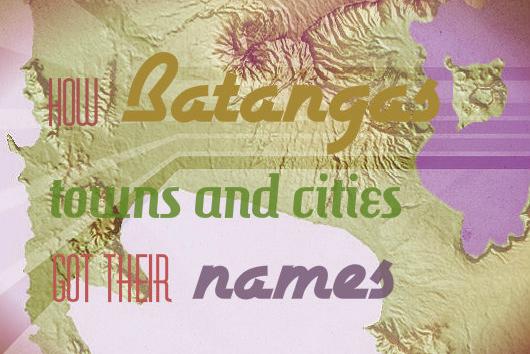Yesterday, we posted on our Facebook page how Lipa City got its name. Then people started thanking us for the tidbit of knowledge and sharing “ah kaya pala” comments on the thread. Then followed questions on the etymologies of Calaca and Lian.
So, to help answer these questions, we thought of collecting trivia on how the names of the towns and cities of Batangas came to be. These are from the history of these towns and cities, either found online or shared to us by reliable sources from the municipality. Most of them are legends though.
We’re doing this by batch so make sure to keep on coming back to our website for the next installments!

ALITAGTAG
The name Alitagtag was derived from “alinagnag” or small light. In the early times, a religious woman found a small light on a tree called Anubing. Days passed and the light vanished. People then believed that it was a holy light. Thereafter, the town was called Alinagnag which later on became Alitagtag.
BAUAN
A couple of towns in Batangas got their names because of miscommunication between Spaniards and Filipinos. Just like Bauan. When Spanish soldiers reached the area, they asked the farmers, who were then planting garlic (or bawang in Filipino), what the place is called. Because they know no Spanish, a farmer answered “bawang”. The Spaniards thought the name of the place is “bawang”. According to Bauan website, it was first registered as Bauang which also means “close or concealed and rugged mountain” in Tagalog.
CALACA
There are two stories how Calaca got its name. Centuries ago, a tribe is called “lakan” or “laka”. And when members of the tribe come across each other, they greet each one with “kalaka!”. Another origin tells this story: one day, a group of Spaniards pass by some locals who were making a hut made of “kalaka” (laka is bamboo split in two). These Spaniards asked them what’s the name of their place and the locals, not being able to understand what the foreigners were saying, they answered “kalaka!”. They were pertaining to what they’re doing and not exactly about their place.
IBAAN
Back then, the land which is now called Ibaan was a huge forest filled with “Iba” trees. Iba looks quite the same as kalamias but their fruits are different in shape – kalamias fruit is oval while the iba fruit is round. Because of the abundance of Iba trees in the area, people living there were called “taga-Ibaan”.
LIPA CITY
Batangueños from the early years had their settlement in Bombon Lake and began dispersing to other places when the volcano erupted. While a group of people was moving to another settlement area, the image of St. Sebastian was stolen from them and later on was found on a tree called “lipa”. People believed that the patron saint wished to name that place “Lipa”.
NASUGBU
Nasugbu got its name the same way Bauan and Calaca did. According to Wikipedia, there was a group of Spaniards wandering around the west coast of Batangas without knowing what the place is called. They chance upon a couple cooking rice in a clay pot and asked them what is the name of the place. The woman was not able to comprehend the question and thought that the Spaniard was asking about the rice she’s cooking. “Nasubo na po iyan, eh, kaya ganyan,” she responded. The Spaniards thought “nasubo” was the name of the place.
How it became Nasugbu? “Sugbu” is actually a Cebuano word meaning on fire or burn. The prefix “na” means “already” in Tagalog. When translated, Nasugbu means “already burned” or “already on fire”.
 WOWBatangas.com Your Source of Great News and Stories from the Province of Batangas, Philippines
WOWBatangas.com Your Source of Great News and Stories from the Province of Batangas, Philippines



